Self-connecting the washing machine
The washing machine must be connected to three networks at once: water supply, sewerage and electricity. Therefore, it is necessary to choose a place for installation so that all three systems are located side by side or it is possible to bring them there. Bath, toilet and kitchen are considered optimal for installing a washing machine - they have all the necessary communications. Most often they require a little work, but connecting the washing machine is not very difficult. The connection process itself is simple, you don't need to do anything super complicated, if you have "straight lines" you can do everything yourself.
The content of the article
Accommodation options
There are several places where you can put your washing machine:
- restroom;
- bathroom or combined bathroom;
- kitchen;
- the corridor.
The most problematic option is the corridor. Usually, the corridor does not have the required communications - no sewage, no water. We'll have to "pull" them to the installation site, which is not easy at all. But sometimes this is the only option. In the photo below, there are several interesting solutions for how you can put a typewriter in the corridor.
- In the photo - the option of installing a washing machine in a narrow corridor
- Making something that looks like a portal is also a way out.
- Hide in the nightstand
- Embed in hallway furniture
There are all communications in the toilet, but in typical high-rise buildings the dimensions of this room are such that it is sometimes difficult to turn around there - there is absolutely no place at all. In this case, put washing machines over the toilet. To do this, make a shelf so that sitting on the toilet does not touch it with your head. It is clear that it must be very strong and reliable, and the machine must have very good shock absorbers. In addition, they must be positioned perfectly, otherwise they can "skip" during the spin cycle. In general, with this method of installing the washing machine, it does not hurt to make several slats that will prevent it from falling off the shelf.
- The shelf is solid and reliable, but slippery - a rubber mat is needed under the legs for shock absorption
- Powerful corners are embedded in the wall, a washing machine is installed on them. The plastic stops were removed from the legs, and holes were drilled in the corners for the remaining screws. The fixation is reliable, it is only important that vibration does not tear the corners out of the wall
- Can be closed with vertical blinds
- This is already a whole locker. Only the doors are missing
There is usually not very much space in the bathroom and the combined bathroom either, but still more than in the toilet. There is a choice. If space is available, you can put a washing machine next to the sink. From above, you can install a tabletop, which will be a logical conclusion, and also solve the problem of water ingress on the case. To make everything look organic, you need to choose a machine of such a height that it fits into the size, and the sink itself is better than a square one - then they will become wall to wall. If there is not enough space, you can push at least part of the case under the sink.
- Place the washing machine next to the sink
- Fashionable bathroom countertops can be decorated with mosaics
- If space permits, just put the machine next to the sink
There is a more compact way - put the washing machine under the sink. Only the sink needs a special shape - so that the siphon is installed at the back.
The next option for installing a washing machine in the bathroom is to the side of the bathtub, between its side and the wall. Today, the size of the cases can be narrow, so this is a reality.
- Narrow hulls are no longer a rarity
- Between the bathroom and the toilet
- The sink should not be smaller than the body
- No one bothers to install the sink from above
Just keep in mind that installing such equipment in bathrooms or a combined bathroom is not the best idea. Due to the high humidity, the case begins to rust quickly (tested on our own experience). However, there is usually not very much space, although in principle, you can put the car under the sink or hang shelves above it. In general, it's up to you.
Another popular place to install a washing machine is in the kitchen. It is embedded in kitchen set... Sometimes they close them with doors, sometimes they don't. This is at the discretion of the owners. Several interesting photos are in the gallery.
- Doors with a cutout for the "porthole"
- Put in the kitchen cabinet
- The washing machine looks quite organic in the kitchen set
Removing the shipping bolts
Before connecting the washing machine, you must unpack it and remove the mounting bolts, put plugs in their place.
This procedure is required immediately after unpacking. Leaving the bolts on and turning on the machine will break it down. And this is not a warranty case. The number of bolts from different manufacturers is different, but the installation diagram is in the instruction manual, and they are visible on the back wall. Just take a screwdriver and unscrew it, close the opened hole with a plug.
Water connection
First, about what kind of water the washing machine is connected to. Generally - to the cold. The water is then heated by heating elements as required. Some owners connect to hot water in order to save money. This way, washing less energy is consumed. But the savings are doubtful - more hot water goes away. If a meter is installed on the hot water supply, it is cheaper to pay for electricity than for hot water. It is also worth considering that connecting the washing machine to hot water is not very good in relation to linen: proteins curl up from temperature and then do not wash well.
This was about ordinary washing machines, but there are models that are connected to both hot water and cold water. They have not one water inlet on the back wall, but two. They are very rare in our country - there is too little demand, and the prices for such equipment are much higher.
Now about the connection itself. The washing machine comes with a rubber hose, which you need to connect the washing machine to water. Its length is 70-80 cm, which is not always enough. If necessary, in shops selling plumbing, you can buy a longer one (3 meters is not the limit, it seems).
This hose is screwed onto the corresponding outlet on the rear wall. There should be a rubber gasket, so there is no need to rewind. Tighten the union nut of the hose (plastic) by hand, if you use wrenches, then just tighten it by half a turn. Not more.
The other end of the hose must be connected to the plumbing system. If you have a free outlet somewhere that ends with a tap - great, if not, you need to make a tie-in.
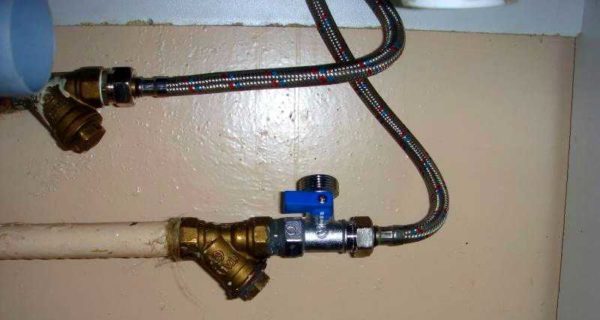
If there is a free drainage of water, it is very simple to connect the washing machine to the water supply system - put a filter, to it - a hose. All
The easiest way is with plastic, polypropylene or metal-plastic pipes - they bought a tee (with one transition to the metal), soldered / installed. If the water supply is divorced with a metal pipe, you will have to embed the tee by welding.
In any case, a tap is placed after the tee. Simpler and cheaper - ball. When installing it, you can wind linseed tow on the thread and grease it with paste.
There are also tees with taps for connecting washing machines and other household appliances.The same ball valve is installed in one of the branches, but everything is done in one body. It looks more compact, but if the crane malfunctions, you will have to change the entire tee, but it costs decently.
Sometimes it is advised to put a filter before the tap. Of course, it will not be superfluous, but if there is a filter at the entrance to an apartment or house, then there is no urgent need for it.
Where to put the drain hose
If there is a sink or sink siphon nearby, there is no problem. You don't even have to redo the sewer. It will be necessary to buy a special siphon with a branch for connecting washing machines and other household appliances and install it instead of the old one.
Another option is to connect the washing machine to the sewer directly. To do this, you can:
- change the sewer tee that goes to the sink;
- make a separate branch.
All these methods require reworking the pipeline, but the connection will be capital. There is one point: the diameter of the drain hose is much smaller than the size of the sewer gadflies. To ensure tightness and to ensure that there is no odor, special rubber cuffs are inserted into the outlets. A hose is simply stuck in them. The elastic edge of the cuff wraps around the cuff, the connection is ready.
There are also temporary connection options. The drain hose is simply dipped into the bathroom, toilet or sink. This method is, of course, very simple, but not the best - the hose may fall, you may forget to put it back in place after turning on the machine, etc. Then the water is drained directly onto the floor, and cleaning up the flood is not very pleasant, and even the neighbors below (if any) will definitely not be happy.
With any method of connecting the drain hose from the machine to the sewer, you must make sure that it does not bend and does not fit in loops. The corrugated drain hose is prone to blockages, therefore it is necessary to observe the minimum bending radius.
All these data are usually prescribed in the instructions, but usually the minimum bend radius is 50 cm, the maximum is 85 cm.In order to control the position of the hose, there are special plastic clamps that are put on top of the corrugation and hold it in the desired position.
Electrical connection
Since the power of the washing machine with the heating elements turned on is decent, it is advisable to bring a separate power line from the panel to it. The scheme is simple - the phase from the input is fed to the circuit breaker, from it it goes to the RCD, then by wire to the place where the outlet is installed.
All manufacturers emphasize that the socket must be grounded. Only in this case the factory guarantees remain valid.
Now about the denominations. The circuit breaker is selected according to the current required by the device. This figure can be found in the passport, or it can be calculated. It is necessary to divide the power of the washing machine by 220 V, we get the consumed current. For example, your unit has a power of 3.5 kW. We get 3500 W / 220 V = 15.9 A. We take the nearest larger one at face value. They are 6 A, 10 A, 16 A, 20 A, 25 A. For our case, a 16 A machine is suitable.
Let's move on to choosing an RCD. In terms of current, it is taken one step higher than the rating of the machine, that is, for the given example, it is 32 A. But the RCD has one more characteristic - the leakage current. For devices that are connected to a dedicated line, the recommended value is 10 mA. So, for a 3.5 kW washing machine, a 16 A machine is required, a 32 A RCD, with a leakage current of 10 mA.
It would also be nice to calculate the cross-section of the wire. Today, cables with copper conductors are mainly used for wiring. They are more flexible, less heavy.The calculation is done by power or by current consumption, but since the range of power of washing machines is limited, we can say right away that for devices up to 4.1 kW, a core section of 1.5 sq. mm (copper conductors), up to 5.5 kW - 2.5 sq. mm.
And the last thing about the electrician: about the sockets. When choosing an outlet, be careful not only for the presence of a grounding contact. You also need to look at what voltage this outlet is designed for. Normal products have markings on the back. The maximum operating voltage is indicated there. Sometimes the rated current is set. You know it too (or you can count it as described above). If there are no inscriptions, it is better not to risk it. Most likely this is a cheap Chinese consumer goods and how it will work is a mystery.
The last stage is setting the level
Connecting the washing machine to the water supply and sewerage system is not all. We need to provide her with normal working conditions. In order for the washing machine not to jump during the spin cycle, it must be set strictly vertically. The position of the body is regulated by means of adjustable legs. They take a building level, put it on the lid, change the height of the legs, ensuring that the bubble in the level is strictly in the center.
Check by laying the level parallel to the front part, then move it to the back wall. Then the procedure is repeated, but the level is applied to the side walls of the case - on one side, then on the other. After the bubble is located strictly in the center in all positions, we can assume that the washing machine is level.
If there is no level, you can try to set the machine by placing a glass with a rim on it, into which water is poured. The water level is along the rim. Change the position until the water is exactly on the rim. This method is less accurate, but better than nothing.
There is one more thing. Most often, washing machines are on a tiled floor, but it is slippery and hard. Therefore, even an ideally positioned machine sometimes "jumps" - it is impossible to extinguish vibration during spinning on a hard floor. To cope with the situation, you can put a rubber mat under the machine. It serves as an excellent shock absorber.

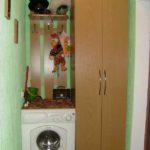
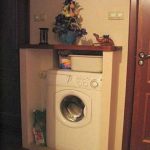
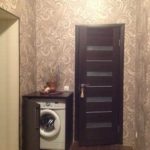
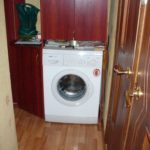
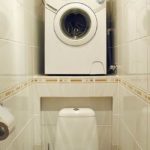
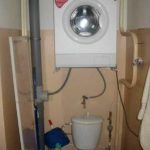
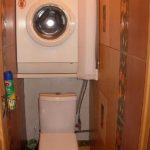
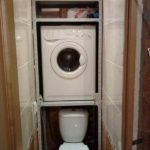
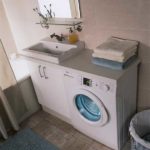
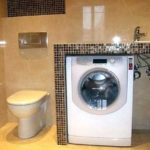

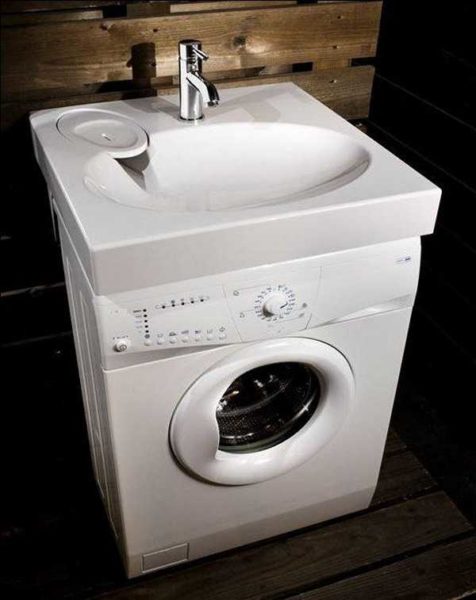
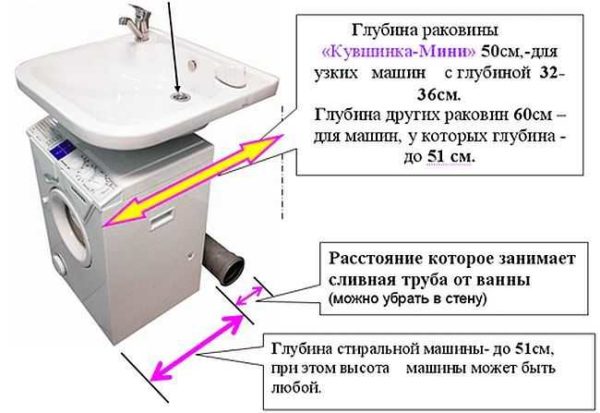
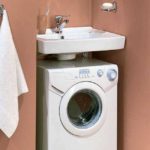
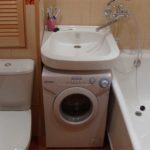
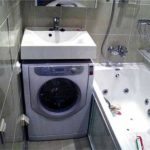
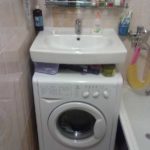
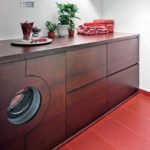




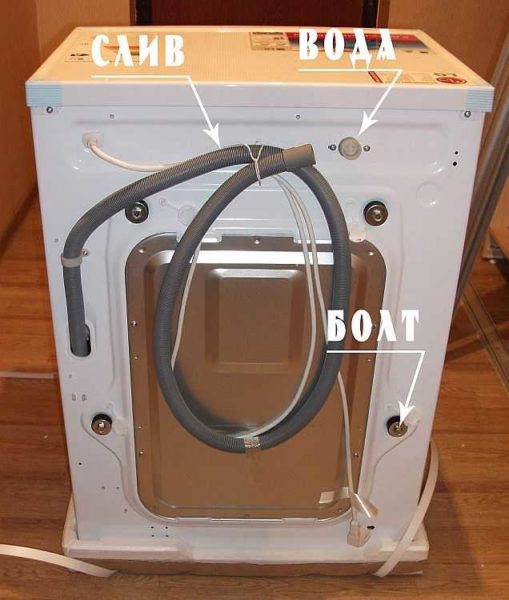
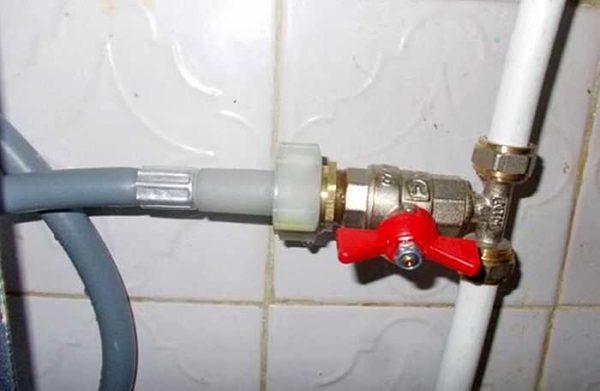
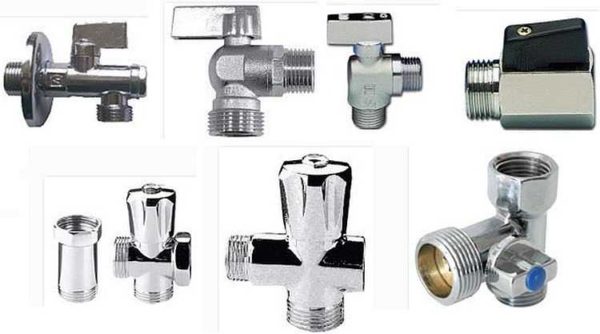
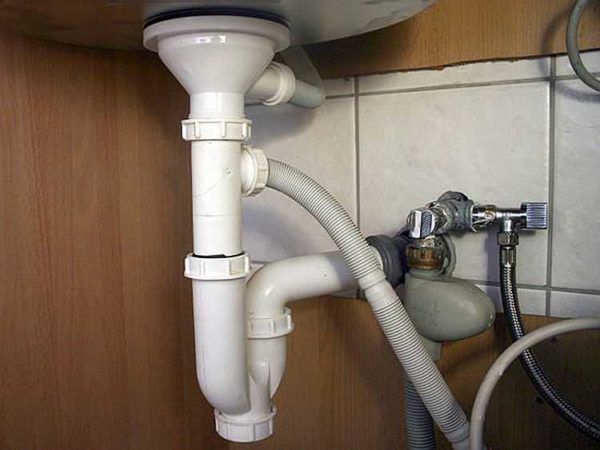
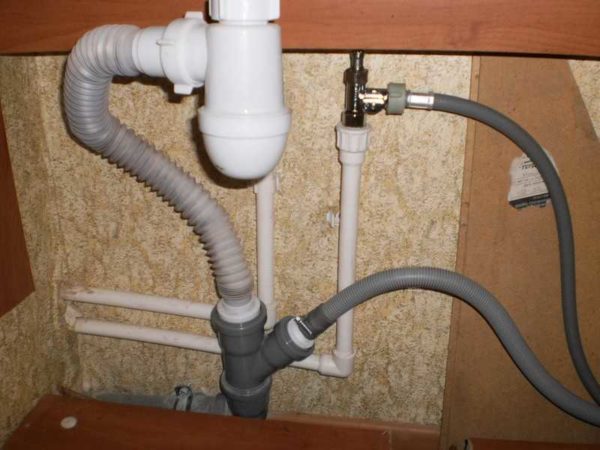
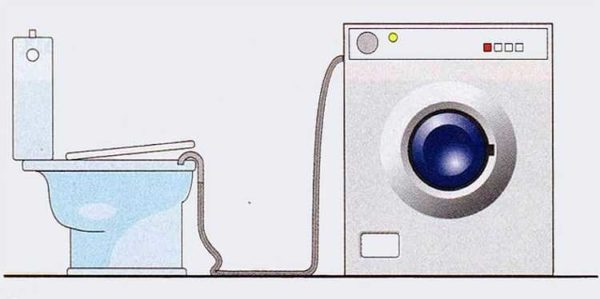
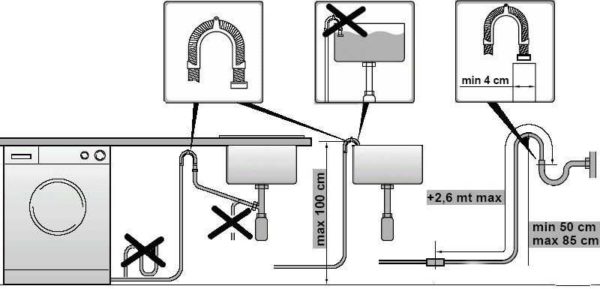
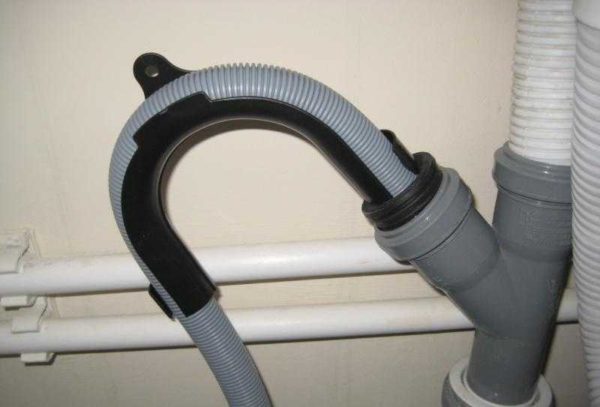
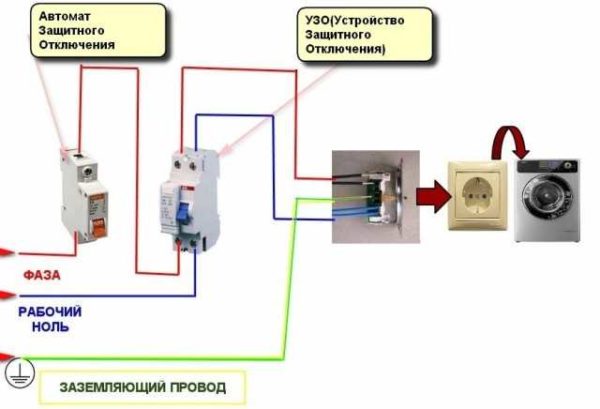
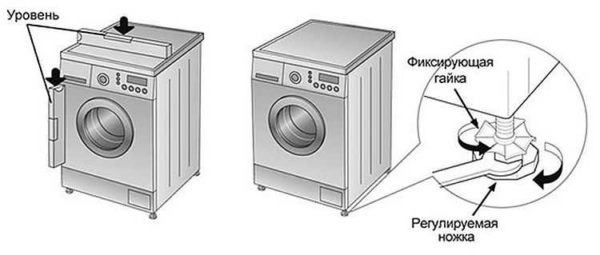

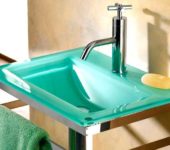
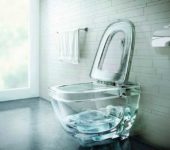

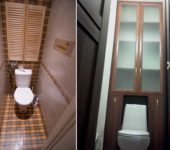





Our plumber connected a washing machine with wiring to the sink) Immediately they killed 2 birds with one stone: they connected the washing machine and put it under the sink. The hotpoint car looks beautiful, its design is good.
Throw off the picture please